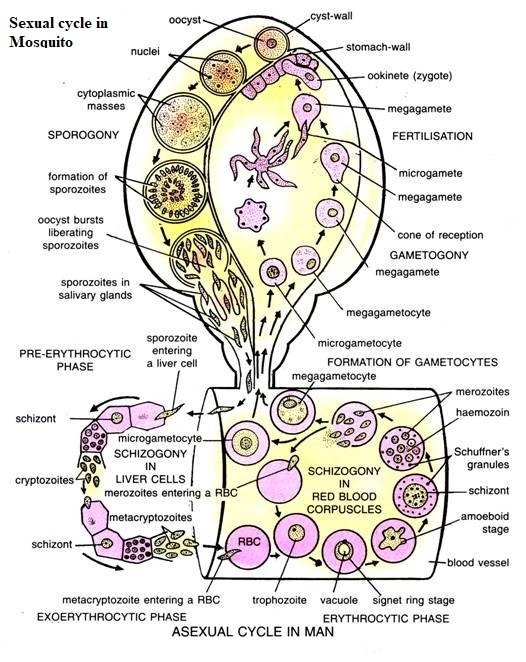
- The life cycle of Plasmodium is digenetic, i.e completed in two hosts.
- The primary host is man where the asexual cycle is completed called schizogony.
- The secondary host is female Anopheles mosquito and the sexual cycle completes in its gut wall or stomach.
- The cycle in mosquito is called sporogony because sporozoites are formed in this cycle.
Schizogony:
- When an infected Anopheles mosquito bites a man, several sporozoiotes with its saliva enter into the blood stream.
- Sporozoites live inside the RBCs and the liver cells thus infecting them.
- This cycle is an endogenous phase as it starts from the red blood corpuscles.
- The followings are the different stages in schizogony:
- Pre-erythrocytic cycle
- Exo-erythrocytic cycle
- Erythrocytic cycle
- Pre-erythrocytic cycle:
- The sporozoites take about half an hour to reach to the liver cells from the blood after the entry into human body.
- They enter into the parenchyma cells of liver where they multiply by shcizogony. This stage is pre-erythrocytic schizogony.
- It completes a single cycle and lasts for about 8 days in vivax, 9 days in P. ovale and 6 days in P.falciparum.
- When it enters the liver cells it becomes spherical and colorless in nature known as cryptozoite
- The nucleus of cryptozoite divides several times and then surrounded by protoplasm to produce small uninucleated crytomerozoites
- Within 8-9 days, a multinucleated structure called schizont is formed.
- When the schizont ruptures, cryptomerozoites are released into liver sinusoids and endothelium.
- Exo-erythrocytic cycle:
- After re-entering in the liver cells, cryptomerozoites trasform into metacrytozoite or phanerozoites.
- It produces two types of structures. One is smaller in size but numerous in number called micro-metacryptomerozoite. The other one is larger and very less in number known as macro-metacryptomerozoite.
- The micro-metacryptomerozoites enter into the RBCs and start the erythrocytic cycle.
- The macro-metacryptomerozoites attack fresh liver cells and continue the exo-erythrocytic cycle.
*secondary exo-erythrocytic schizogony, which occurs in P.vivax and P.ovale characteristically is absent in P.falciparum and a true relapse in absent in P.falciparum infection because of the absence of hypnozoites (the stage responsible for relapse).
- Erythrocytic cycle:
- The erythrocytic cycle begins when the RBCs are attacked by the micro-cryptomerozoites.
- The sequential stages of the parasite in RBCs are as follows:
Trophozoite —–> Signet ring stage —–> Amoeboid stage —–> Rosette stage —–> Schizont —–> Merozoiotes —–> Gametocytes
- Every merozoite enters into the RBCs and forms a rounded disc-like shape known as trophozoite.
- It feeds on haemoglobin of RBCs and grows in size. After sometime, a new vacuole appears in the parasite.
- It increases in size and pushes the nucleus to another side forming a ring like structure called signet-ring stage.
- In this way, the consumed haemoglobin gives energy to the parasite.
- The unused haematin forms the characteristic yellowish, brown or black colored poisonous hameozoin.
- The vacuoles disappear and it appears amoeboid shaped inside the RBC.
- The RBCs become double in size ad due to deficiency of haemoglobin appear pale in color. It develops numerous granules on its surface known as Schuffner’s dot.
- The trophozoite then fully matures and completely fills the RBC and changes into a schizont.
- The nucleus of the schizont divides and come to lie on the periphery of the cell with hamemozoin molecules lying at the center.
- Some protoplasm encircles around each nucleus and small schizonts arrange like the petals of a rose flower. So this stage is known as rosette stage.
- After sometime, the rosette stage RBCs burst and the schizonts (cryptozoites) along with haemozoin are released in the blood plasma.
- Some of the liberated cryptozoites are destryoyed by white blood cells and some others attack the fresh and healthy RBCs.
- The whole cycle is known as Golgi cycle and it takes about 48-72 hours for completion.
- Thus, due to the destruction of RBCs by the parasites and the release of haemozoin into the blood stream, the patient suffers from anemia and shows fever.
- The time between the mosquito bite and the appearance of the symptoms like fever (like fever) in man, is known as the incubation period, which generally ranges from 10- 14 days.
- Some merozoites invade the new erythrocytes and instead of developing into schizonts, develop into male microgametocytes or female macrogametocyres. produce gametocytes. The merozoites which fail to form gametocytes enter into new liver cells and continue post-erythrocytic cycle.
- The gametocytes circulate in the blood stream and reach in the blood vessels of the spleen and bone marrow and develop in the RBCs present there.
- It is fully grown within 96 hours and reaches in the superficial blood vessels with the release of much haemozoin. From blood they easily pass on to the mosquito’s body during the mosquito bite for blood meal.
